Distinguishing diffuse alopecia areata (AA) from pattern hair loss (PHL) using CD3+ T cells
May 2016
in “Journal of The American Academy of Dermatology”
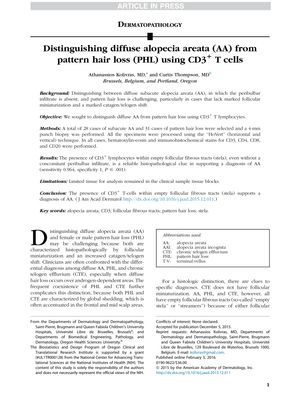
TLDR CD3+ T-cell presence is a reliable marker to tell apart alopecia areata from pattern hair loss.
The study conducted biopsies on 28 cases of subacute alopecia areata (AA) and 31 cases of pattern hair loss (PHL) to determine if CD3+ T lymphocytes could be used to differentiate between the two conditions. The biopsies were processed and stained for various immune cells, including CD3+ T cells. The findings indicated that the presence of CD3+ lymphocytes within empty follicular fibrous tracts was a highly sensitive (0.964) and specific (1.000) indicator for diagnosing AA, particularly when peribulbar lymphocytes were absent. The study concluded that CD3+ T-cell presence within these tracts is a reliable histopathological marker for AA, offering a new diagnostic tool to distinguish AA from PHL. However, the study faced limitations due to the limited tissue available for analysis.
View this study on jaad.org →
Cited in this study
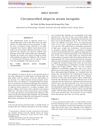
research Circumscribed alopecia areata incognita
A rare form of alopecia causes hair thinning without bald spots and may be more common than thought, responding well to steroid treatment.
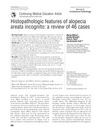
research Histopathologic features of alopecia areata incognito: a review of 46 cases
The research found specific signs to diagnose alopecia areata incognito and noted patients generally regrow hair after steroid treatment.
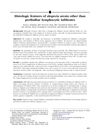
research Histologic features of alopecia areata other than peribulbar lymphocytic infiltrates
Other common signs, not just the well-known immune cells around hair bulbs, are important for diagnosing hair loss from alopecia areata.
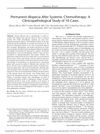
research Permanent Alopecia After Systemic Chemotherapy: A Clinicopathological Study of 10 Cases
Chemotherapy can cause permanent, non-reversible hair loss similar to pattern baldness.
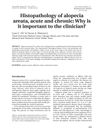
research Histopathology of alopecia areata, acute and chronic: Why is it important to the clinician?
Recognizing the different stages of alopecia areata is crucial for accurate diagnosis and treatment.
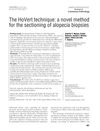
research The HoVert technique: a novel method for the sectioning of alopecia biopsies
The HoVert technique is a simple, cost-effective new method that improves alopecia diagnosis by allowing detailed analysis from a single biopsy.
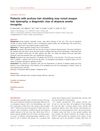
research Patients with profuse hair shedding may reveal anagen hair dystrophy: a diagnostic clue of alopecia areata incognita
Some people with heavy hair shedding might actually have a hidden form of alopecia, which can be identified by specific hair changes.
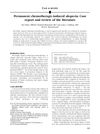
research Permanent chemotherapy-induced alopecia: Case report and review of the literature
Some chemotherapy can cause permanent hair loss.
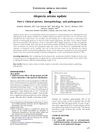
research Alopecia areata update
Half of people with Alopecia Areata may see hair regrowth within a year without treatment, but recovery is unpredictable.
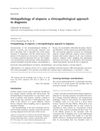
research Histopathology of alopecia: a clinicopathological approach to diagnosis
The conclusion is that accurate diagnosis of different types of hair loss requires good teamwork between skin doctors and lab experts.

research Hair counts in scalp biopsy of males and females with androgenetic alopecia compared with normal subjects
AGA patients have fewer hairs and smaller follicles; T:V ratio above 4:1 may indicate AGA.
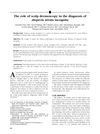
research The role of scalp dermoscopy in the diagnosis of alopecia areata incognita
Scalp dermoscopy is good for diagnosing a type of hair loss and helps choose the best spots for biopsy.

research Follicular miniaturization in female pattern hair loss: clinicopathological correlations
Hair loss severity relates to increased miniaturization in female pattern hair loss.
Related
research Alopecia areata: A multifactorial autoimmune condition
Alopecia areata is an autoimmune disease causing patchy hair loss, often with other autoimmune disorders, but its exact causes are unknown.
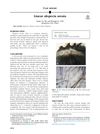
research Linear alopecia areata
Alopecia areata can sometimes appear as a straight line of hair loss instead of round patches.
research Treating of resistant cases of alopecia universalis
Combining platelet-rich plasma therapy with prostaglandin-F eye drops can significantly regrow hair in alopecia universalis.